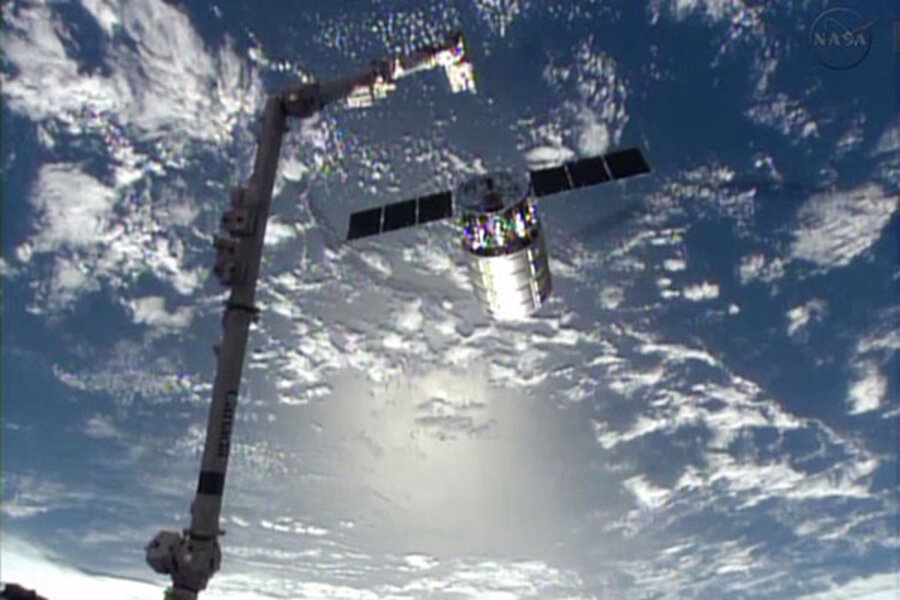Success of Cygnus cargo craft takes NASA step closer to new future
Loading...
The second of two commercial spacecraft NASA has tapped to resupply the International Space Station wrapped up its qualifying run to the orbiting outpost successfully on Tuesday. It now is headed for incineration when it reenters Earth's atmosphere on Wednesday.
Astronauts aboard the space station used the station's robotic arm to gently move Orbital Sciences Corporation's Cygnus cargo craft away from the station, releasing it at 7:31 Eastern Daylight Time on Tuesday.
It was a wipe-the-brow moment for NASA. For eight years, the agency has worked to outsource cargo-hauling duties to the space station in anticipation of retiring the space shuttles in 2011. The agency was tasked with refocusing its human-spaceflight program on exploration beyond low-Earth orbit.
While the space agency and Congress are still sorting out those next steps, NASA is claiming success for its work to stimulate the emergence of companies that own and operate their own rockets and cargo craft.
“We are delighted to now have two American companies able to resupply the station,” NASA Administrator Charles Bolden Jr. said in a statement Tuesday, referring to Space Exploration Technologies (SpaceX) in addition to Orbital Sciences. “Orbital's success today is helping make NASA's future exploration to farther destinations possible.”
Orbital Sciences, based in Dulles, Va., launched Cygnus atop the company's Antares rocket Sept. 18. The launch took place at the Mid-Atlantic Regional Spaceport, on the grounds of NASA's Wallops Island Flight Facility on the Virgina coast. The craft was to have docked with the space station four days later. But a software glitch prevented an initial attempt at a rendezvous.
Software engineers fixed the problem. But the delay prompted mission controllers to hold off on a second rendezvous attempt until an incoming Russian Soyuz spacecraft could deliver three crew members to the station. The Soyuz craft arrived on Sept. 25. Cygnus docked four days later, carrying some 1,300 pounds of food, clothes, and experiments designed by elementary, middle-school, and high-school students.
Like the robotic cargo craft supplied by the Russians, Europeans, and Japanese, Cygnus is designed to haul trash for incineration in Earth's atmosphere once the crew has released it. That leaves SpaceX's Dragon spacecraft as the only post-shuttle cargo carrier capable of returning hardware or experiments to Earth.
Orbital Sciences expects to launch its first full-scale cargo mission in December under a $1.9 billion contract with NASA, according to Frank Culbertson, Orbital Sciences' vice-president in charge of the company's human-spaceflight activities. SpaceX, based in Hawthorne, Calif., will follow closely on Orbital's heels with a launch in January 2014, the third launch under that company's $1.6-billion contract with NASA for cargo service.
NASA began its Commercial Orbital Transportation Service (COTS) program “to kick-start the commercial space industry, without knowing if anything would actually emerge from that,” said Alan Lindenmoyer, who heads NASA's efforts to foster commercial cargo and crew transportation to the space station, in September. In addition, the agency hoped what emerged would lower the cost of launching cargo and people to space safely and reliably.
If all worked as planned, NASA would become the anchor customer for the emergent companies, Mr. Lindenmoyer said.
For its part, Orbital Sciences was a late-comer to the effort. In May 2006, NASA originally contracted with SpaceX and another firm, Kistler Aerospace Corporation and Rocketplane, Ltd., to begin the path toward their first demonstration flights. In January 2008, Orbital Science replaced Kistler after Kistler had failed to meet two important milestones in its contract.
Looking back on the objectives NASA had for the cargo portion of its COTS program, Mr. Lindenmoyer added: “I think we can say conclusively that we've added another partner to the list that helped us achieve these goals 100 percent. We now have two new launch vehicles, two new state-of-the-art autonomous spacecraft capable of carrying cargo to human destinations in space, two new launch pads, two new mission controls – the entire infrastructure to support these two new systems.”






